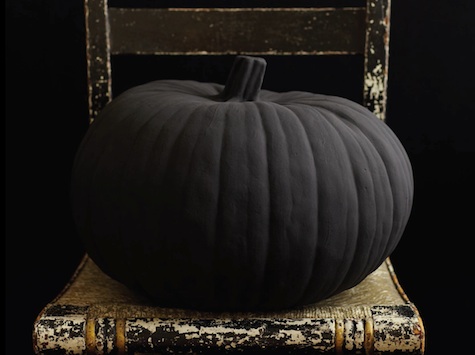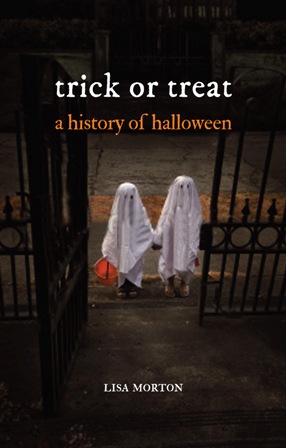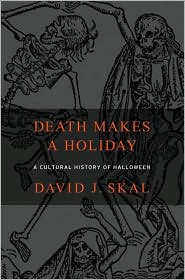
As reported by the Boston Globe, "The history of Halloween," by Katharine Whittemore, on 26 October 2013 -- It’s that time of year again: Halloween, when we eat marinated carp, celebrate Martin Luther’s 95 theses, and put out bowls of butter to salve the wounds of the dead. Who doesn’t love Halloween, when we throw nuts into the fire to predict whom we’ll marry, and enter a house only after firing a shot over the roof and having the owner fire back? Forget Tootsie Rolls. Forget UNICEF boxes. Forget kids in ninja costumes. This bizarrely enigmatic, riotously evolving pagan-Christian-Celtic-American-Hollywood-hyper-retail-creepingly-global holiday is “undoubtedly the most misunderstood of festivals.”
Or so I learned in “Trick or Treat: A History of Halloween” (Reaktion, 2012) by Lisa Morton, a leading authority on the holiday. Her book is my lively source for the guns (a Shetland Islands tradition) and butter (a German practice). But those are just two oddities out of many.

When reading about Halloween, it’s all strange tidings for an American holiday second only to Christmas, now, for over-the-top observance and marketplace wallop. Yet there’s a gap here. Or maybe a spooky chasm with a fog machine and polyester cobwebs: For centuries, Halloween’s great popularity resulted in scant analysis. Lucky for us, insights have been piling up in the last few decades, and Morton’s book is one of the more recent, mainstream efforts in the world of Halloween studies. (Yes, ghoulfriend, there is such a thing).
It follows in the slipstream of the first scholarly conference ever held on Halloween, which took place in Glasgow in 2006. The choice of city was no accident: Most histories of Halloween give the Scots top credit for kindling and stoking the holiday. Indeed, a century ago Halloween cards featured lots of plaid and thistles. It’s debatable whether our festival grew out of the Gaelic-Celtic harvest bash Samhain (for “summer’s end,” and pronounced “sow-in”). Samhain was full of bonfires and feasts. Fairies and spirits were said to thrive then too, though they could be evil so it was best if they didn’t recognize you. Thus, it seems some revelers took to wearing disguises. So when you’re at a Halloween party this year, and sidle up to Walter White or Daft Punk, you can tell them their couture is linked to a druidical sense of existential anxiety. Or something like that.
Just as the early Christian Church overlaid Christmas on a pagan winter solstice festival, and Easter on spring solstice, Halloween became tied to harvest time and All Saints Day, celebrated on Nov. 1 — “hallow” sprung from the Old English word for “holy” and “e’en” is a contraction of “evening,” thus “Halloween” for the night before. This religious heritage, however, has withered so much that many evangelical Christians today object to Halloween for its satanic overtones; they even hold alternative Hallelujah Nights on Oct. 31. Reach into Morton’s book and you’ll pull out oodles more informational candies: For a long time, Halloween was mostly about fortune-telling, and the “treat” stuff only kicked into high gear after World War II when sugar rationing ended. Also, it’s big in Scandinavia, but moribund in Australia.

Which brings us to “Death Makes a Holiday: A Cultural History of Halloween” (Bloomsbury USA, 2003) by David J. Skal. Modern Halloween, he says, is a “patchwork holiday, a kind of cultural Frankenstein stitched together quite recently from a number of traditions.” I particularly liked his treatment of the 1970s Halloween scares (apples with razors, bubble gum with lye), outing them as urban myths. He also talks about how fear is a money maker: many think a financially teetering Knott’s Berry Farm, for instance, was saved by annually adding a Knott’s Scary Farm attraction. And he covers how American exports like the “Halloween” slasher movie franchise have spread the holiday to a Europe that paid it little mind before. (In France, though, Halloween has not even un peu traction. They find it too ugly American.)
Skal also has some great stuff on Halloween pranking. In the Depression, the poor pranked the rich with near menace, and during World War II, pranks were frowned upon (why soap a car with rationed soap?). He quotes a Rochester, N.Y., school superintendent who pointed out how “[e]ven ringing doorbells has lost its appeal because it may mean disturbing the sleep of a tired war worker who needs his rest.”

Americans seem pretty lightweight compared to that. Indeed, all our faux ghosts, mummies, and skeletons fall in the realm of “safe danger,” as Rogers writes. “Flirtation with fear,” is how Joanna Bourke puts it in “Fear: A Cultural History” (Counterpoint, 2007). This book has much to say about how children, especially, try out their dark emotions in a protected context like Halloween or scary movies and literature. It also talks about how Western cultures now know great inchoate anxieties about terrorism or spying or pandemics, but as individuals we have much less direct contact with death and dying than our forebears did, when infant mortality rates were higher and people died younger. As such, death in today’s Halloween (much less souls and saints) has become marginalized. Now it’s about providing “a space for social transgression and parody,” according to Rogers.

Transgression and parody light up Lesley Pratt Bannatyne’s “Halloween Nation: Behind the Scenes of America’s Fright Night” (Pelican, 2011). This is a quasi oral-history, with plenty of photos, and commentary from names like Garrison Keillor, native of Anoka, Minn., “Halloween Capital of the World,” plus endearing curiosities like a custom fang maker, horror movie actress, and several New Englanders, such as a Topsfield pumpkin grower, Halloween pranksters at MIT, and Boston’s own horror burlesque dancer, Devilicia. Bannatyne is quite the queen of the night herself, and though it’s dated, her “Halloween: An American Holiday, an American History” (Pelican, 1998) expertly traces how the Scottish and Irish brought pseudo-Samhain to Uncle Sam, reenergizing the holiday with each immigrant wave.
You know you’re in an academic book when a professor gushes about the “sheer polysemy” of Halloween. I had to look up the word; it means “many meanings.” Which is just what you get in “Trick or Treat? Halloween in a Globalising World” (Cambridge Scholars Publishing, 2009). It’s edited by Malcolm Foley and Hugh O’Donnell, professors at Glasgow Caledonian University, and showcases papers from that Scottish Halloween conference.
They’re all obscurely insightful, and often inadvertently amusing for their high/low-culture juxtaposition. Take “Halloween in a Situation Comedy: Postmodernity, Tradition, and Identity,” which analyzes a Catalan sitcom in which a fierce nationalist refuses to drink Halloween punch since it’s “an imperialist beverage,” and “Resisting Halloween in Slovenia: A Case of Anti-Americanism,” in which the local press sneers that this Yank import “is perfect for today’s meaningless consumer culture.” Which goes to show that whether you think Halloween is a treat or a trick, it’s scary how significant it is. (source: Boston Globe )

Happy Halloweeen !!! Here we brings some DIY Creepy Halloween Decoration Ideas for you to celebrate this Halloween event and make it memorable. You can also check History of Halloween as well as Halloween Customs and Traditions on our this blog post. For more details please follow our blogs Halloween Ideas 2018.
ReplyDeleteAre you confused? Just Like me? Do you want to know? Is Halloween a pagan holiday?
ReplyDelete
ReplyDeletehalloween day
halloween facts
history of halloween timeline
what is halloween
history of halloween costumes
history of halloween in canada
halloween day
halloween facts
what is halloween
samhain
all hallows eve
halloween
ReplyDeleteI'm amazed some SJW isn't saying that dressing like a ghost in a white sheet on Halloween is racist.happy halloween images
ReplyDeleteYou did.
DeleteAre you looking for 10 facts about halloween
ReplyDeleteI think these are the best
christmas day
ReplyDeletechristmas date
christmas history
christmas information
when is christmas eve
christmas celebration
origin of christmas
new year's day 2019
images of happy christmas day
happy christmas day 2017
happy christmas images download
inspirational christmas quotes
christmas quotes about family
short christmas quotes
christmas quotes funny
inspirational holiday quotes
christmas song quotes
lest we forget remembrance day quotes
ReplyDeleteremembrance quotes and sayings
short remembrance day poems
remembrance day quotes for loved ones
short remembrance quotes
remembrance day what to say
remembrance day speech
remembrance day messages on wreaths
poppy images free use
remembrance images free
poppy images for facebook
poppy photos lest we forget
poppy images free remembrance
remembrance poppy images
pictures of poppies to download
pictures of poppies flowers
I like this article. I was searching over search engines and found your blog and it’s really helps thank you so much:
ReplyDeleteThe Voice 2020 winner
who wins The Voice 2020 spoiler
winner of The Voice 2020
The Voice 2020 winner
who wins The Voice 2020 spoiler
winner of The Voice 2020
American idol 2020 winner
American idol winner 2020
winner of American idol 2020
American idol 2020 winner
American idol winner 2020
winner of American idol 2020
AGT 2020 Winner Spoiler Predictions
Americas got Talent 2020 Winner Spoiler
American Shows Spoiler Winner Episodes
The Voice Australia 2020 Episode Start Date Winner Name
The Voice Australia 2020 Episode Start Date Winner Name
Australia Got Talent 2020 Episode Start Date Winner Name